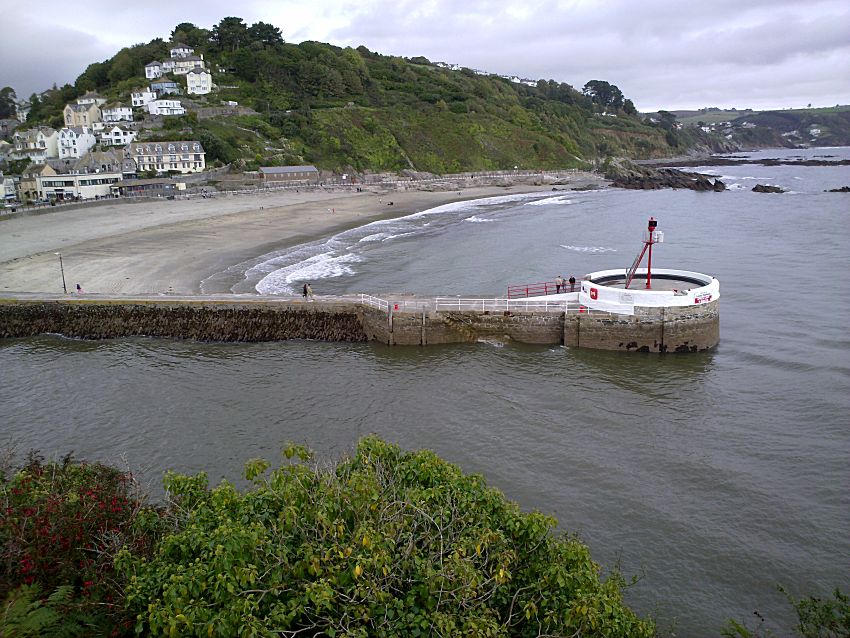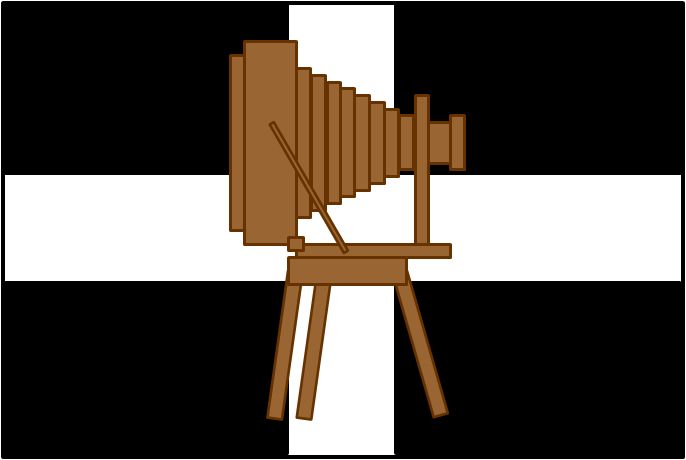(1) Photographs taken 2008 to 2010
See also Looe Harbour for more images around Looe Harbour, and Looe Town for more photos of landmarks around the town of East Looe.
Looe is not to be missed, and is a lively fishing port, and shopping and eating out haunt. Pilchards and fishing, mining and copper export, and smuggling have all played a part in this busy port's history, and to that can now be added beaches, lifeboats, fishing trips, and festivals.
Prior to the modern fishing boats now in use, most fishing was done using the famous "Looe Luggers", as was no doubt, an amount of smuggling in days past! Looe Island became a bit of a local hotspot in that regard. A very Cornish economy!

Looe Luggers in the harbour (photo 2004)
Looe itself is more than amply described by Wilkie Collins in his "Rambles Beyond Railways" of 1851:
"At each side of you rise high ranges of beautifully wooded hills; here and there a cottage peeps out among the trees, the winding path that leads to it being now lost to sight in the thick foliage, now visible again as a thin serpentine line of soft grey. Midway on the slopes appear the gardens of Looe, built up the acclivity on stone terraces one above another; thus displaying the veritable garden architecture of the mountains of Palestine magically transplanted to the side of an English hill. Here, in this soft and genial atmosphere, the hydrangea is a common flower-bed ornament, the fuchsia grows lofty and luxuriant in the poorest cottage garden, the myrtle flourishes close to the sea-shore, and the tender tamarisk is the wild plant of every farmer's hedge. Looking lower down the hills yet, you see the houses of the town straggling out towards the sea along each bank of the river, in mazes of little narrow streets; curious old quays project over the water at different points; coast-trade vessels are being loaded and unloaded, built in one place and repaired in another, all within view; while the prospect of hills, harbour, and houses thus quaintly combined together, is beautifully closed by the English Channel, just visible as a small strip of blue water, pent in between the ridges of two promontories which stretch out on either side to the beach."
And the pasties aren't bad either! And for a splendid old-fashioned hostelry, and good food, you would do far worse than to visit the fine establishment that is the "Olde Salutation Inne" in Fore Street.

The harbour at Looe
Looe is made up of the contrasting twin towns of East Looe and West Looe. On the east side is where the main shops are, the famous Banjo Pier, sandy beaches, and the terminus for the Looe Valley Line - now a very pretty train link from Liskeard (where you can use the "Park & Ride" scheme), that is all that now remains of the old Liskeard and Caradon Railway that linked Looe with the mines and quarries on Bodmin Moor. On the west side, there is the quieter and very pretty sea-front along towards Hannafore, where you can park and walk along the front, or go down amongst the rock pools on the shore. Here there are views directly over to St.George's Island half a mile off-shore (known locally as Looe Island), which was made famous by the two Atkins sisters ("We Bought an Island" by Evelyn Atkins), and which is now a Cornish Wildlife Trust nature reserve.
Looe Beach and the Banjo Pier
The Banjo Pier was built to protect the busy port of Looe in the nineteenth century - there was previously only a wooden groyne there - from where copper and granite was exported from the heights of Bodmin Moor. The ore and minerals were brought down to Looe by canal from Liskeard, and later by the Looe, Liskeard and Caradon Railway.

The Banjo Pier at Looe late in the season
The beach at Looe is popular at any time of the year for a wander, but particularly so during the Summer - compare the photos above and below!

The Banjo Pier earlier in the season!

Looe Harbour Entrance and a spot of Gig Racing about to start

Looe Gig Racing - with "Zeus" having a bit of a bad start!

The Banjo Pier on a calm day and big skies

The Banjo Pier is perfect for a little contemplation
(2) Photographs taken 2016 to 2018

Looe Beach

The beach and cliffs to the east of the main beach - looking towards
Plaidy and Millendreath

Looe Town and Beach from the Banjo Pier

Looking up the harbour from the Banjo Pier

The Old Lifeboat House on Looe seafront, overlooking the beach
The Harbour and River
The Fish Quay in Looe is a busy one, as most of the fishing done here is done by "day fishing" only, and by working the tides in and out of the river. Consequently, fish bought in Looe, especially when bought directly from the Fish Quay, will be among the freshest and best fish you will ever get.
For more images of the harbour, see the Looe Harbour page.

The harbour at Looe, with its mix of leisure and fishing boats

Looe Bridge

Looe Bridge from the up-river side

Looe War Memorial just below the bridge on the east side

Looking up-river from Looe Bridge - the East Looe River is ahead,
and the West Looe river to the right beyond the boatyard

The house at Trenat Point, where the West Looe and East Looe rivers
meet - access only by boat or long walk!

Looe Island, seen from Hannafore in West Looe
(for more images
and information about Looe Island, see the
Looe Island and Visit to Looe
Island pages)

The extensive and very accessible rockpools off the beach in West
Looe - a naturalist's paradise!
(looking back towards Hannafore
in West Looe)

More delightful rockpools looking out across Looe Bay towards Seaton
and Downderry

There are plenty of tourist and fishing boat trips available from
the quay in Looe

Jonathan Livingston has been spotted on his travels in many places
in Cornwall now!

"Where's Jonathan?" -
Jonathan Livingston has many cousins... but unfortunately they like
pasties, so watch out!
See also Looe Harbour for more images around Looe Harbour, and Looe Town for more photos of landmarks around the town of East Looe.


Connect with us, Like us and Follow us on Facebook!
PhotoFile Cornwall supports CoaST and Sustainable Tourism